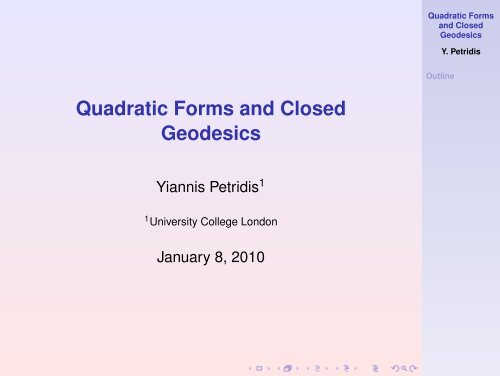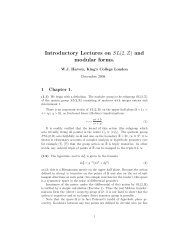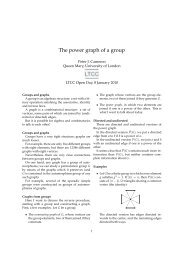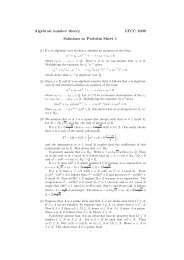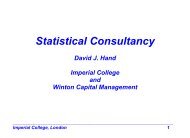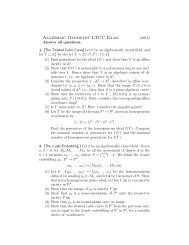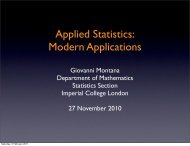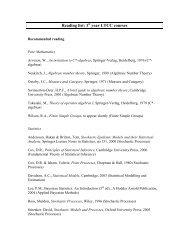Quadratic Forms and Closed Geodesics
Quadratic Forms and Closed Geodesics
Quadratic Forms and Closed Geodesics
You also want an ePaper? Increase the reach of your titles
YUMPU automatically turns print PDFs into web optimized ePapers that Google loves.
<strong>Quadratic</strong> <strong>Forms</strong><br />
<strong>and</strong> <strong>Closed</strong><br />
<strong>Geodesics</strong><br />
Y. Petridis<br />
Outline<br />
<strong>Quadratic</strong> <strong>Forms</strong> <strong>and</strong> <strong>Closed</strong><br />
<strong>Geodesics</strong><br />
Yiannis Petridis 1<br />
1 University College London<br />
January 8, 2010
Outline<br />
<strong>Quadratic</strong> <strong>Forms</strong><br />
<strong>and</strong> <strong>Closed</strong><br />
<strong>Geodesics</strong><br />
Y. Petridis<br />
<strong>Quadratic</strong> <strong>Forms</strong><br />
<strong>Quadratic</strong> <strong>Forms</strong><br />
Hyperbolic surfaces<br />
Hyperbolic<br />
surfaces<br />
<strong>Closed</strong><br />
<strong>Geodesics</strong><br />
Spectral Theory<br />
<strong>Closed</strong> <strong>Geodesics</strong><br />
Spectral Theory
Pell’s Equation<br />
<strong>Quadratic</strong> <strong>Forms</strong><br />
<strong>and</strong> <strong>Closed</strong><br />
<strong>Geodesics</strong><br />
Y. Petridis<br />
◮ Algorithm for solving<br />
x 2 − 2y 2 = ±1<br />
(Pythagoreans)<br />
◮ Start with<br />
◮ We get<br />
x 1 = 1, y 1 = 1<br />
(x 2 , y 2 ) = (3, 2)<br />
(x 3 , y 3 ) = (7, 5)<br />
(x 4 , y 4 ) = (17, 12)<br />
◮ Recurrences<br />
x n+1 = x n + 2y n<br />
y n+1 = x n + y n<br />
◮ Fundamental solution:<br />
1 + √ 2<br />
x n + √ 2y n = (1 + √ 2) n<br />
<strong>Quadratic</strong> <strong>Forms</strong><br />
Hyperbolic<br />
surfaces<br />
<strong>Closed</strong><br />
<strong>Geodesics</strong><br />
Spectral Theory
Pell’s Equation<br />
<strong>Quadratic</strong> <strong>Forms</strong><br />
<strong>and</strong> <strong>Closed</strong><br />
<strong>Geodesics</strong><br />
Y. Petridis<br />
◮ Algorithm for solving<br />
x 2 − 2y 2 = ±1<br />
(Pythagoreans)<br />
◮ Start with<br />
◮ We get<br />
x 1 = 1, y 1 = 1<br />
(x 2 , y 2 ) = (3, 2)<br />
(x 3 , y 3 ) = (7, 5)<br />
(x 4 , y 4 ) = (17, 12)<br />
◮ Recurrences<br />
x n+1 = x n + 2y n<br />
y n+1 = x n + y n<br />
◮ Fundamental solution:<br />
1 + √ 2<br />
x n + √ 2y n = (1 + √ 2) n<br />
<strong>Quadratic</strong> <strong>Forms</strong><br />
Hyperbolic<br />
surfaces<br />
<strong>Closed</strong><br />
<strong>Geodesics</strong><br />
Spectral Theory
Pell’s Equation<br />
<strong>Quadratic</strong> <strong>Forms</strong><br />
<strong>and</strong> <strong>Closed</strong><br />
<strong>Geodesics</strong><br />
Y. Petridis<br />
◮ Algorithm for solving<br />
x 2 − 2y 2 = ±1<br />
(Pythagoreans)<br />
◮ Start with<br />
◮ We get<br />
x 1 = 1, y 1 = 1<br />
(x 2 , y 2 ) = (3, 2)<br />
(x 3 , y 3 ) = (7, 5)<br />
(x 4 , y 4 ) = (17, 12)<br />
◮ Recurrences<br />
x n+1 = x n + 2y n<br />
y n+1 = x n + y n<br />
◮ Fundamental solution:<br />
1 + √ 2<br />
x n + √ 2y n = (1 + √ 2) n<br />
<strong>Quadratic</strong> <strong>Forms</strong><br />
Hyperbolic<br />
surfaces<br />
<strong>Closed</strong><br />
<strong>Geodesics</strong><br />
Spectral Theory
Pell’s Equation<br />
<strong>Quadratic</strong> <strong>Forms</strong><br />
<strong>and</strong> <strong>Closed</strong><br />
<strong>Geodesics</strong><br />
Y. Petridis<br />
◮ Algorithm for solving<br />
x 2 − 2y 2 = ±1<br />
(Pythagoreans)<br />
◮ Start with<br />
◮ We get<br />
x 1 = 1, y 1 = 1<br />
(x 2 , y 2 ) = (3, 2)<br />
(x 3 , y 3 ) = (7, 5)<br />
(x 4 , y 4 ) = (17, 12)<br />
◮ Recurrences<br />
x n+1 = x n + 2y n<br />
y n+1 = x n + y n<br />
◮ Fundamental solution:<br />
1 + √ 2<br />
x n + √ 2y n = (1 + √ 2) n<br />
<strong>Quadratic</strong> <strong>Forms</strong><br />
Hyperbolic<br />
surfaces<br />
<strong>Closed</strong><br />
<strong>Geodesics</strong><br />
Spectral Theory
Pell’s Equation<br />
<strong>Quadratic</strong> <strong>Forms</strong><br />
<strong>and</strong> <strong>Closed</strong><br />
<strong>Geodesics</strong><br />
Y. Petridis<br />
◮ Algorithm for solving<br />
x 2 − 2y 2 = ±1<br />
(Pythagoreans)<br />
◮ Start with<br />
◮ We get<br />
x 1 = 1, y 1 = 1<br />
(x 2 , y 2 ) = (3, 2)<br />
(x 3 , y 3 ) = (7, 5)<br />
(x 4 , y 4 ) = (17, 12)<br />
◮ Recurrences<br />
x n+1 = x n + 2y n<br />
y n+1 = x n + y n<br />
◮ Fundamental solution:<br />
1 + √ 2<br />
x n + √ 2y n = (1 + √ 2) n<br />
<strong>Quadratic</strong> <strong>Forms</strong><br />
Hyperbolic<br />
surfaces<br />
<strong>Closed</strong><br />
<strong>Geodesics</strong><br />
Spectral Theory
Indefinite <strong>Quadratic</strong> <strong>Forms</strong><br />
◮ Q(x, y) = ax 2 + bxy + cy 2 , d = b 2 − 4ac > 0<br />
( ) t ( ) ( )<br />
x x a b/2<br />
◮ Q(x, y) = M M =<br />
y y<br />
b/2 c<br />
◮ Which integers are represented by Q, i.e.<br />
Q(x, y) = N,<br />
x, y, N ∈ N<br />
<strong>Quadratic</strong> <strong>Forms</strong><br />
<strong>and</strong> <strong>Closed</strong><br />
<strong>Geodesics</strong><br />
Y. Petridis<br />
<strong>Quadratic</strong> <strong>Forms</strong><br />
Hyperbolic<br />
surfaces<br />
<strong>Closed</strong><br />
<strong>Geodesics</strong><br />
Spectral Theory<br />
Equivalence of <strong>Quadratic</strong> <strong>Forms</strong><br />
Q ∼ Q ′ ⇒ they represent the same integers.<br />
( ) 0 −1<br />
◮ x 2 − 2y 2 ∼ −2x 2 + y 2 ◮ S =<br />
1 0<br />
◮ x 2 − 2y 2 ∼ x 2 + 2xy − y 2 ( ) 1 1<br />
T =<br />
0 1<br />
◮ (x + y) 2 − 2y 2 = x 2 + 2xy − y 2<br />
Q(x + y, y) = Q ′ (x, y) <strong>and</strong> Q ′ (x − y, y) = Q(x, y)
Indefinite <strong>Quadratic</strong> <strong>Forms</strong><br />
◮ Q(x, y) = ax 2 + bxy + cy 2 , d = b 2 − 4ac > 0<br />
( ) t ( ) ( )<br />
x x a b/2<br />
◮ Q(x, y) = M M =<br />
y y<br />
b/2 c<br />
◮ Which integers are represented by Q, i.e.<br />
Q(x, y) = N,<br />
x, y, N ∈ N<br />
<strong>Quadratic</strong> <strong>Forms</strong><br />
<strong>and</strong> <strong>Closed</strong><br />
<strong>Geodesics</strong><br />
Y. Petridis<br />
<strong>Quadratic</strong> <strong>Forms</strong><br />
Hyperbolic<br />
surfaces<br />
<strong>Closed</strong><br />
<strong>Geodesics</strong><br />
Spectral Theory<br />
Equivalence of <strong>Quadratic</strong> <strong>Forms</strong><br />
Q ∼ Q ′ ⇒ they represent the same integers.<br />
( ) 0 −1<br />
◮ x 2 − 2y 2 ∼ −2x 2 + y 2 ◮ S =<br />
1 0<br />
◮ x 2 − 2y 2 ∼ x 2 + 2xy − y 2 ( ) 1 1<br />
T =<br />
0 1<br />
◮ (x + y) 2 − 2y 2 = x 2 + 2xy − y 2<br />
Q(x + y, y) = Q ′ (x, y) <strong>and</strong> Q ′ (x − y, y) = Q(x, y)
Indefinite <strong>Quadratic</strong> <strong>Forms</strong><br />
◮ Q(x, y) = ax 2 + bxy + cy 2 , d = b 2 − 4ac > 0<br />
( ) t ( ) ( )<br />
x x a b/2<br />
◮ Q(x, y) = M M =<br />
y y<br />
b/2 c<br />
◮ Which integers are represented by Q, i.e.<br />
Q(x, y) = N,<br />
x, y, N ∈ N<br />
<strong>Quadratic</strong> <strong>Forms</strong><br />
<strong>and</strong> <strong>Closed</strong><br />
<strong>Geodesics</strong><br />
Y. Petridis<br />
<strong>Quadratic</strong> <strong>Forms</strong><br />
Hyperbolic<br />
surfaces<br />
<strong>Closed</strong><br />
<strong>Geodesics</strong><br />
Spectral Theory<br />
Equivalence of <strong>Quadratic</strong> <strong>Forms</strong><br />
Q ∼ Q ′ ⇒ they represent the same integers.<br />
( ) 0 −1<br />
◮ x 2 − 2y 2 ∼ −2x 2 + y 2 ◮ S =<br />
1 0<br />
◮ x 2 − 2y 2 ∼ x 2 + 2xy − y 2 ( ) 1 1<br />
T =<br />
0 1<br />
◮ (x + y) 2 − 2y 2 = x 2 + 2xy − y 2<br />
Q(x + y, y) = Q ′ (x, y) <strong>and</strong> Q ′ (x − y, y) = Q(x, y)
Indefinite <strong>Quadratic</strong> <strong>Forms</strong><br />
◮ Q(x, y) = ax 2 + bxy + cy 2 , d = b 2 − 4ac > 0<br />
( ) t ( ) ( )<br />
x x a b/2<br />
◮ Q(x, y) = M M =<br />
y y<br />
b/2 c<br />
◮ Which integers are represented by Q, i.e.<br />
Q(x, y) = N,<br />
x, y, N ∈ N<br />
<strong>Quadratic</strong> <strong>Forms</strong><br />
<strong>and</strong> <strong>Closed</strong><br />
<strong>Geodesics</strong><br />
Y. Petridis<br />
<strong>Quadratic</strong> <strong>Forms</strong><br />
Hyperbolic<br />
surfaces<br />
<strong>Closed</strong><br />
<strong>Geodesics</strong><br />
Spectral Theory<br />
Equivalence of <strong>Quadratic</strong> <strong>Forms</strong><br />
Q ∼ Q ′ ⇒ they represent the same integers.<br />
( ) 0 −1<br />
◮ x 2 − 2y 2 ∼ −2x 2 + y 2 ◮ S =<br />
1 0<br />
◮ x 2 − 2y 2 ∼ x 2 + 2xy − y 2 ( ) 1 1<br />
T =<br />
0 1<br />
◮ (x + y) 2 − 2y 2 = x 2 + 2xy − y 2<br />
Q(x + y, y) = Q ′ (x, y) <strong>and</strong> Q ′ (x − y, y) = Q(x, y)
Indefinite <strong>Quadratic</strong> <strong>Forms</strong><br />
◮ Q(x, y) = ax 2 + bxy + cy 2 , d = b 2 − 4ac > 0<br />
( ) t ( ) ( )<br />
x x a b/2<br />
◮ Q(x, y) = M M =<br />
y y<br />
b/2 c<br />
◮ Which integers are represented by Q, i.e.<br />
Q(x, y) = N,<br />
x, y, N ∈ N<br />
<strong>Quadratic</strong> <strong>Forms</strong><br />
<strong>and</strong> <strong>Closed</strong><br />
<strong>Geodesics</strong><br />
Y. Petridis<br />
<strong>Quadratic</strong> <strong>Forms</strong><br />
Hyperbolic<br />
surfaces<br />
<strong>Closed</strong><br />
<strong>Geodesics</strong><br />
Spectral Theory<br />
Equivalence of <strong>Quadratic</strong> <strong>Forms</strong><br />
Q ∼ Q ′ ⇒ they represent the same integers.<br />
( ) 0 −1<br />
◮ x 2 − 2y 2 ∼ −2x 2 + y 2 ◮ S =<br />
1 0<br />
◮ x 2 − 2y 2 ∼ x 2 + 2xy − y 2 ( ) 1 1<br />
T =<br />
0 1<br />
◮ (x + y) 2 − 2y 2 = x 2 + 2xy − y 2<br />
Q(x + y, y) = Q ′ (x, y) <strong>and</strong> Q ′ (x − y, y) = Q(x, y)
Indefinite <strong>Quadratic</strong> <strong>Forms</strong><br />
◮ Q(x, y) = ax 2 + bxy + cy 2 , d = b 2 − 4ac > 0<br />
( ) t ( ) ( )<br />
x x a b/2<br />
◮ Q(x, y) = M M =<br />
y y<br />
b/2 c<br />
◮ Which integers are represented by Q, i.e.<br />
Q(x, y) = N,<br />
x, y, N ∈ N<br />
<strong>Quadratic</strong> <strong>Forms</strong><br />
<strong>and</strong> <strong>Closed</strong><br />
<strong>Geodesics</strong><br />
Y. Petridis<br />
<strong>Quadratic</strong> <strong>Forms</strong><br />
Hyperbolic<br />
surfaces<br />
<strong>Closed</strong><br />
<strong>Geodesics</strong><br />
Spectral Theory<br />
Equivalence of <strong>Quadratic</strong> <strong>Forms</strong><br />
Q ∼ Q ′ ⇒ they represent the same integers.<br />
( ) 0 −1<br />
◮ x 2 − 2y 2 ∼ −2x 2 + y 2 ◮ S =<br />
1 0<br />
◮ x 2 − 2y 2 ∼ x 2 + 2xy − y 2 ( ) 1 1<br />
T =<br />
0 1<br />
◮ (x + y) 2 − 2y 2 = x 2 + 2xy − y 2<br />
Q(x + y, y) = Q ′ (x, y) <strong>and</strong> Q ′ (x − y, y) = Q(x, y)
Class Numbers<br />
h(d) = number of inequivalent forms of discriminant d.<br />
h(d) d=<br />
1 5, 8, 12, 13, 17, 21, 24, 28, 29, 33, 37, 41, 44, 53<br />
2 40, 60, 65, 85, 104, 105, 120, 136, 140, 156, 165<br />
3 229, 257, 316, 321, 469, 473, 568, 733, 761, 892<br />
4 145, 328, 445, 505, 520, 680, 689, 777, 780, 793<br />
5 401, 817, 1093, 1393, 1429, 1641, 1756, 1897, ...<br />
◮ D = {d|d > 0, d ≡ 0, 1 (mod 4), d ≠ □}<br />
◮ x 2 − dy 2 = 4, fundamental solution (t, u)<br />
ɛ d = t + u√ d<br />
2<br />
◮ Gauss, Siegel (1944)<br />
∑<br />
h(d) log ɛ d = π2 x 3/2<br />
+ O(x log x).<br />
18ζ(3)<br />
d∈D,d≤x<br />
ζ(s) =<br />
∞∑<br />
n=1<br />
1<br />
, R(s) > 1.<br />
ns <strong>Quadratic</strong> <strong>Forms</strong><br />
<strong>and</strong> <strong>Closed</strong><br />
<strong>Geodesics</strong><br />
Y. Petridis<br />
<strong>Quadratic</strong> <strong>Forms</strong><br />
Hyperbolic<br />
surfaces<br />
<strong>Closed</strong><br />
<strong>Geodesics</strong><br />
Spectral Theory
Class Numbers<br />
h(d) = number of inequivalent forms of discriminant d.<br />
h(d) d=<br />
1 5, 8, 12, 13, 17, 21, 24, 28, 29, 33, 37, 41, 44, 53<br />
2 40, 60, 65, 85, 104, 105, 120, 136, 140, 156, 165<br />
3 229, 257, 316, 321, 469, 473, 568, 733, 761, 892<br />
4 145, 328, 445, 505, 520, 680, 689, 777, 780, 793<br />
5 401, 817, 1093, 1393, 1429, 1641, 1756, 1897, ...<br />
◮ D = {d|d > 0, d ≡ 0, 1 (mod 4), d ≠ □}<br />
◮ x 2 − dy 2 = 4, fundamental solution (t, u)<br />
ɛ d = t + u√ d<br />
2<br />
◮ Gauss, Siegel (1944)<br />
∑<br />
h(d) log ɛ d = π2 x 3/2<br />
+ O(x log x).<br />
18ζ(3)<br />
d∈D,d≤x<br />
ζ(s) =<br />
∞∑<br />
n=1<br />
1<br />
, R(s) > 1.<br />
ns <strong>Quadratic</strong> <strong>Forms</strong><br />
<strong>and</strong> <strong>Closed</strong><br />
<strong>Geodesics</strong><br />
Y. Petridis<br />
<strong>Quadratic</strong> <strong>Forms</strong><br />
Hyperbolic<br />
surfaces<br />
<strong>Closed</strong><br />
<strong>Geodesics</strong><br />
Spectral Theory
Class Numbers<br />
h(d) = number of inequivalent forms of discriminant d.<br />
h(d) d=<br />
1 5, 8, 12, 13, 17, 21, 24, 28, 29, 33, 37, 41, 44, 53<br />
2 40, 60, 65, 85, 104, 105, 120, 136, 140, 156, 165<br />
3 229, 257, 316, 321, 469, 473, 568, 733, 761, 892<br />
4 145, 328, 445, 505, 520, 680, 689, 777, 780, 793<br />
5 401, 817, 1093, 1393, 1429, 1641, 1756, 1897, ...<br />
◮ D = {d|d > 0, d ≡ 0, 1 (mod 4), d ≠ □}<br />
◮ x 2 − dy 2 = 4, fundamental solution (t, u)<br />
ɛ d = t + u√ d<br />
2<br />
◮ Gauss, Siegel (1944)<br />
∑<br />
h(d) log ɛ d = π2 x 3/2<br />
+ O(x log x).<br />
18ζ(3)<br />
d∈D,d≤x<br />
ζ(s) =<br />
∞∑<br />
n=1<br />
1<br />
, R(s) > 1.<br />
ns <strong>Quadratic</strong> <strong>Forms</strong><br />
<strong>and</strong> <strong>Closed</strong><br />
<strong>Geodesics</strong><br />
Y. Petridis<br />
<strong>Quadratic</strong> <strong>Forms</strong><br />
Hyperbolic<br />
surfaces<br />
<strong>Closed</strong><br />
<strong>Geodesics</strong><br />
Spectral Theory
From <strong>Quadratic</strong> <strong>Forms</strong> to Hyperbolic<br />
Geometry<br />
Q(x, y) = ax 2 + bxy + cy 2<br />
az 2 + bz + c = 0 ⇔ z 1 = −b+√ d<br />
2a<br />
, z 2 = −b−√ d<br />
2a<br />
<strong>Quadratic</strong> <strong>Forms</strong><br />
<strong>and</strong> <strong>Closed</strong><br />
<strong>Geodesics</strong><br />
Y. Petridis<br />
<strong>Quadratic</strong> <strong>Forms</strong><br />
Hyperbolic<br />
surfaces<br />
<strong>Closed</strong><br />
<strong>Geodesics</strong><br />
Spectral Theory<br />
*<br />
(!b!d^(1/2))/2a<br />
x<br />
(!b+d^(1/2))/2a
From <strong>Quadratic</strong> <strong>Forms</strong> to Hyperbolic<br />
Geometry<br />
Q(x, y) = ax 2 + bxy + cy 2<br />
az 2 + bz + c = 0 ⇔ z 1 = −b+√ d<br />
2a<br />
, z 2 = −b−√ d<br />
2a<br />
<strong>Quadratic</strong> <strong>Forms</strong><br />
<strong>and</strong> <strong>Closed</strong><br />
<strong>Geodesics</strong><br />
Y. Petridis<br />
<strong>Quadratic</strong> <strong>Forms</strong><br />
Hyperbolic<br />
surfaces<br />
<strong>Closed</strong><br />
<strong>Geodesics</strong><br />
Spectral Theory<br />
(!b!d^(1/2))/2a<br />
x<br />
(!b+d^(1/2))/2a
Linear Fractional Transformations <strong>and</strong><br />
SL 2 (R)<br />
T (z) = az + b , ad − bc ≠ 0<br />
cz + d<br />
maps ( circles)<br />
to circles<br />
a b<br />
γ =<br />
→ T (z)<br />
c d<br />
{ ( a b<br />
SL 2 (R) = γ =<br />
c d<br />
acts on<br />
Upper-half space<br />
)<br />
}<br />
, ad − bc = 1<br />
H = {z = x + iy, y > 0} ds 2 = dx 2 + dy 2<br />
z(t) = x(t) + iy(t), t ∈ [a, b], L = ∫ b<br />
a<br />
◮ z → z + 1<br />
y<br />
√ 2<br />
x ′ (t) 2 +y ′ (t) 2<br />
y(t)<br />
dt<br />
<strong>Quadratic</strong> <strong>Forms</strong><br />
<strong>and</strong> <strong>Closed</strong><br />
<strong>Geodesics</strong><br />
Y. Petridis<br />
<strong>Quadratic</strong> <strong>Forms</strong><br />
Hyperbolic<br />
surfaces<br />
<strong>Closed</strong><br />
<strong>Geodesics</strong><br />
Spectral Theory<br />
◮ z → − 1 z<br />
Γ = SL 2 (Z) = {γ ∈ SL 2 (R), a, b, c, d ∈ Z}
The Hyperbolic Disc<br />
<strong>Quadratic</strong> <strong>Forms</strong><br />
<strong>and</strong> <strong>Closed</strong><br />
<strong>Geodesics</strong><br />
Y. Petridis<br />
<strong>Quadratic</strong> <strong>Forms</strong><br />
◮ Model of hyperbolic<br />
geometry<br />
H = {z = x + iy, |z| < 1}<br />
Hyperbolic<br />
surfaces<br />
<strong>Closed</strong><br />
<strong>Geodesics</strong><br />
Spectral Theory<br />
◮ Hyperbolic metric<br />
ds 2 =<br />
dx 2 + dy 2<br />
(1 − (x 2 + y 2 )) 2<br />
d(0, z) = ln 1 + |z|<br />
1 − |z| ,
<strong>Geodesics</strong> in Hyperbolic Disc<br />
<strong>Quadratic</strong> <strong>Forms</strong><br />
<strong>and</strong> <strong>Closed</strong><br />
<strong>Geodesics</strong><br />
Y. Petridis<br />
<strong>Quadratic</strong> <strong>Forms</strong><br />
Hyperbolic<br />
surfaces<br />
<strong>Closed</strong><br />
<strong>Geodesics</strong><br />
Spectral Theory<br />
◮ Semicircles perpendicular to<br />
boundary<br />
◮ Diameters
<strong>Geodesics</strong> in the Upper Half Plane<br />
<strong>Quadratic</strong> <strong>Forms</strong><br />
<strong>and</strong> <strong>Closed</strong><br />
<strong>Geodesics</strong><br />
Y. Petridis<br />
<strong>Quadratic</strong> <strong>Forms</strong><br />
Hyperbolic<br />
surfaces<br />
<strong>Closed</strong><br />
<strong>Geodesics</strong><br />
Spectral Theory<br />
(!b!d^(1/2))/2a<br />
x<br />
(!b+d^(1/2))/2a
Fundamental Domains<br />
z ∼ w ⇔ w = T (z), T ∈ Γ<br />
H/Γ the modular surface<br />
<strong>Quadratic</strong> <strong>Forms</strong><br />
<strong>and</strong> <strong>Closed</strong><br />
<strong>Geodesics</strong><br />
Y. Petridis<br />
<strong>Quadratic</strong> <strong>Forms</strong><br />
Hyperbolic<br />
surfaces<br />
<strong>Closed</strong><br />
<strong>Geodesics</strong><br />
Spectral Theory
Arithmetic subgroups of SL 2 (Z)<br />
Example<br />
Fundamental Domain for Γ 0 (6)<br />
<strong>Quadratic</strong> <strong>Forms</strong><br />
<strong>and</strong> <strong>Closed</strong><br />
<strong>Geodesics</strong><br />
Y. Petridis<br />
<strong>Quadratic</strong> <strong>Forms</strong><br />
Hyperbolic<br />
surfaces<br />
<strong>Closed</strong><br />
<strong>Geodesics</strong><br />
Spectral Theory<br />
Hecke subgroups Γ 0 (N)<br />
az + b<br />
cz + d ∈ SL 2(Z), N|c
¡<br />
Tesselations<br />
<strong>Quadratic</strong> <strong>Forms</strong><br />
<strong>and</strong> <strong>Closed</strong><br />
<strong>Geodesics</strong><br />
Y. Petridis<br />
<strong>Quadratic</strong> <strong>Forms</strong><br />
Hyperbolic<br />
surfaces<br />
T 1 F<br />
F<br />
TF<br />
<strong>Closed</strong><br />
<strong>Geodesics</strong><br />
Spectral Theory<br />
T 1 JF<br />
JF<br />
T JF<br />
T 2 UTF<br />
T 1 U 2 F<br />
T 1 UTF<br />
U 2 F<br />
UTF<br />
TU 2 F<br />
1<br />
0 1<br />
1<br />
Figure: Translates of the<br />
fundamental domain of<br />
SL 2 (Z)<br />
Figure: Triangles in the<br />
disc
Equivalence of <strong>Quadratic</strong> forms <strong>and</strong><br />
SL 2 (R)<br />
Q ′ ∼ Q ⇔ M ′ = γ t Mγ, γ ∈ Γ.<br />
Q → g =<br />
( t−bu<br />
)<br />
2<br />
−cu<br />
∈ Γ<br />
au<br />
t+bu<br />
2<br />
where t 2 − du 2 = 4 <strong>and</strong> (t, u) is the fundamental<br />
(smallest solution).<br />
Remarks: 1. g has eigenvalue ɛ d = t + u√ d<br />
2<br />
2. Most g ∈ SL 2 (R) can be diagonalised<br />
g ∼<br />
( N(g)<br />
1/2<br />
0<br />
0 N(g) −1/2 )<br />
.<br />
<strong>Quadratic</strong> <strong>Forms</strong><br />
<strong>and</strong> <strong>Closed</strong><br />
<strong>Geodesics</strong><br />
Y. Petridis<br />
<strong>Quadratic</strong> <strong>Forms</strong><br />
Hyperbolic<br />
surfaces<br />
<strong>Closed</strong><br />
<strong>Geodesics</strong><br />
Spectral Theory
Pell’s Equation <strong>and</strong> Lengths of <strong>Closed</strong><br />
<strong>Geodesics</strong><br />
<strong>Quadratic</strong> <strong>Forms</strong><br />
<strong>and</strong> <strong>Closed</strong><br />
<strong>Geodesics</strong><br />
Y. Petridis<br />
<strong>Quadratic</strong> <strong>Forms</strong><br />
Hyperbolic<br />
surfaces<br />
N(g)<br />
1<br />
∫ N(g)<br />
1<br />
1<br />
y dy = ln N(g) = ln(ɛ2 d )<br />
<strong>Closed</strong><br />
<strong>Geodesics</strong><br />
Spectral Theory<br />
x<br />
1<br />
N(g)<br />
Theorem<br />
The lengths of the closed geodesics for the hyperbolic<br />
surface H/SL 2 (Z) are 2 log ɛ d with multiplicity h(d),<br />
d ∈ D.
Distribution <strong>Closed</strong> geodesics of H/Γ<br />
<strong>Quadratic</strong> <strong>Forms</strong><br />
<strong>and</strong> <strong>Closed</strong><br />
<strong>Geodesics</strong><br />
Y. Petridis<br />
<strong>Closed</strong> geodesics γ.<br />
Prime Geodesic Theorem Prime Number Theorem<br />
◮ π(x) = {γ, length (γ) ≤ ln x}<br />
π(x) ∼<br />
x<br />
◮ π(x) = {p prime, p ≤ x}<br />
ln x , x → ∞ π(x) ∼<br />
x<br />
ln x , x → ∞<br />
◮ Class number distribution (Sarnak, 1982)<br />
∑<br />
d∈D,ɛ d ≤x<br />
h(d) ∼ x 2<br />
2 ln x<br />
<strong>Quadratic</strong> <strong>Forms</strong><br />
Hyperbolic<br />
surfaces<br />
<strong>Closed</strong><br />
<strong>Geodesics</strong><br />
Spectral Theory
Distribution <strong>Closed</strong> geodesics of H/Γ<br />
<strong>Quadratic</strong> <strong>Forms</strong><br />
<strong>and</strong> <strong>Closed</strong><br />
<strong>Geodesics</strong><br />
Y. Petridis<br />
<strong>Closed</strong> geodesics γ.<br />
Prime Geodesic Theorem Prime Number Theorem<br />
◮ π(x) = {γ, length (γ) ≤ ln x}<br />
π(x) ∼<br />
x<br />
◮ π(x) = {p prime, p ≤ x}<br />
ln x , x → ∞ π(x) ∼<br />
x<br />
ln x , x → ∞<br />
◮ Class number distribution (Sarnak, 1982)<br />
∑<br />
d∈D,ɛ d ≤x<br />
h(d) ∼ x 2<br />
2 ln x<br />
<strong>Quadratic</strong> <strong>Forms</strong><br />
Hyperbolic<br />
surfaces<br />
<strong>Closed</strong><br />
<strong>Geodesics</strong><br />
Spectral Theory
Distribution <strong>Closed</strong> geodesics of H/Γ<br />
<strong>Quadratic</strong> <strong>Forms</strong><br />
<strong>and</strong> <strong>Closed</strong><br />
<strong>Geodesics</strong><br />
Y. Petridis<br />
<strong>Closed</strong> geodesics γ.<br />
Prime Geodesic Theorem Prime Number Theorem<br />
◮ π(x) = {γ, length (γ) ≤ ln x}<br />
π(x) ∼<br />
x<br />
◮ π(x) = {p prime, p ≤ x}<br />
ln x , x → ∞ π(x) ∼<br />
x<br />
ln x , x → ∞<br />
◮ Class number distribution (Sarnak, 1982)<br />
∑<br />
d∈D,ɛ d ≤x<br />
h(d) ∼ x 2<br />
2 ln x<br />
<strong>Quadratic</strong> <strong>Forms</strong><br />
Hyperbolic<br />
surfaces<br />
<strong>Closed</strong><br />
<strong>Geodesics</strong><br />
Spectral Theory
The Laplace Operator<br />
<strong>Quadratic</strong> <strong>Forms</strong><br />
<strong>and</strong> <strong>Closed</strong><br />
<strong>Geodesics</strong><br />
Y. Petridis<br />
<strong>Quadratic</strong> <strong>Forms</strong><br />
( )<br />
∂<br />
∆ = −y 2 2<br />
∂x 2 + ∂2<br />
∂y 2<br />
∆f = 0 ⇔ f is harmonic<br />
Eigenvalue problem: Solve<br />
Hyperbolic<br />
surfaces<br />
<strong>Closed</strong><br />
<strong>Geodesics</strong><br />
Spectral Theory<br />
∆f = λf<br />
Infinite Matrix, no determinant to compute eigenvalues.<br />
I require f (γz) = f (z), γ ∈ Γ (automorphic form)
Contour plots of eigenfunctions of H/Γ 0 (7)<br />
<strong>Quadratic</strong> <strong>Forms</strong><br />
<strong>and</strong> <strong>Closed</strong><br />
<strong>Geodesics</strong><br />
Y. Petridis<br />
<strong>Quadratic</strong> <strong>Forms</strong><br />
Hyperbolic<br />
surfaces<br />
<strong>Closed</strong><br />
<strong>Geodesics</strong><br />
Spectral Theory<br />
Figure: λ = 37.08033 λ = 692.7292
Contour plots of eigenfunctions of H/Γ 0 (3)<br />
<strong>Quadratic</strong> <strong>Forms</strong><br />
<strong>and</strong> <strong>Closed</strong><br />
<strong>Geodesics</strong><br />
Y. Petridis<br />
<strong>Quadratic</strong> <strong>Forms</strong><br />
Hyperbolic<br />
surfaces<br />
<strong>Closed</strong><br />
<strong>Geodesics</strong><br />
Spectral Theory<br />
Figure: λ = 26.3467 λ = 60.4397
The Riemann Hypothesis<br />
◮ Think of<br />
∞∑<br />
n=0<br />
z n = 1<br />
1 − z .<br />
Series: |z| < 1, 1/(1 − z), z ≠ 1.<br />
∞∑ 1<br />
◮ ζ(s) = ,<br />
ns R(s) > 1.<br />
n=1<br />
Extend to 1/2 ≤ R(s), then to C using functional<br />
equation<br />
<strong>Quadratic</strong> <strong>Forms</strong><br />
<strong>and</strong> <strong>Closed</strong><br />
<strong>Geodesics</strong><br />
Y. Petridis<br />
<strong>Quadratic</strong> <strong>Forms</strong><br />
Hyperbolic<br />
surfaces<br />
<strong>Closed</strong><br />
<strong>Geodesics</strong><br />
Spectral Theory<br />
−1+s Γ((1 − s)/2)<br />
ζ(s) = π ζ(1 − s).<br />
Γ(s/2)<br />
Zeros: ρ, 1 − ρ symmetric around R(s) = 1/2.<br />
Riemann Hypothesis<br />
R(ρ) = 1/2 ALWAYS
The Riemann Hypothesis<br />
◮ Think of<br />
∞∑<br />
n=0<br />
z n = 1<br />
1 − z .<br />
Series: |z| < 1, 1/(1 − z), z ≠ 1.<br />
∞∑ 1<br />
◮ ζ(s) = ,<br />
ns R(s) > 1.<br />
n=1<br />
Extend to 1/2 ≤ R(s), then to C using functional<br />
equation<br />
<strong>Quadratic</strong> <strong>Forms</strong><br />
<strong>and</strong> <strong>Closed</strong><br />
<strong>Geodesics</strong><br />
Y. Petridis<br />
<strong>Quadratic</strong> <strong>Forms</strong><br />
Hyperbolic<br />
surfaces<br />
<strong>Closed</strong><br />
<strong>Geodesics</strong><br />
Spectral Theory<br />
−1+s Γ((1 − s)/2)<br />
ζ(s) = π ζ(1 − s).<br />
Γ(s/2)<br />
Zeros: ρ, 1 − ρ symmetric around R(s) = 1/2.<br />
Riemann Hypothesis<br />
R(ρ) = 1/2 ALWAYS
The Riemann Hypothesis<br />
◮ Think of<br />
∞∑<br />
n=0<br />
z n = 1<br />
1 − z .<br />
Series: |z| < 1, 1/(1 − z), z ≠ 1.<br />
∞∑ 1<br />
◮ ζ(s) = ,<br />
ns R(s) > 1.<br />
n=1<br />
Extend to 1/2 ≤ R(s), then to C using functional<br />
equation<br />
<strong>Quadratic</strong> <strong>Forms</strong><br />
<strong>and</strong> <strong>Closed</strong><br />
<strong>Geodesics</strong><br />
Y. Petridis<br />
<strong>Quadratic</strong> <strong>Forms</strong><br />
Hyperbolic<br />
surfaces<br />
<strong>Closed</strong><br />
<strong>Geodesics</strong><br />
Spectral Theory<br />
−1+s Γ((1 − s)/2)<br />
ζ(s) = π ζ(1 − s).<br />
Γ(s/2)<br />
Zeros: ρ, 1 − ρ symmetric around R(s) = 1/2.<br />
Riemann Hypothesis<br />
R(ρ) = 1/2 ALWAYS
Relations of RH with spectral theory<br />
Scattering of waves on H/Γ<br />
<strong>Quadratic</strong> <strong>Forms</strong><br />
<strong>and</strong> <strong>Closed</strong><br />
<strong>Geodesics</strong><br />
Y. Petridis<br />
<strong>Quadratic</strong> <strong>Forms</strong><br />
Hyperbolic<br />
surfaces<br />
<strong>Closed</strong><br />
<strong>Geodesics</strong><br />
Spectral Theory<br />
φ(s) = √ π<br />
Γ(s − 1/2)ζ(2s − 1)<br />
Γ(s)ζ(2s)<br />
Poles of φ(s) at ρ/2.<br />
RH⇔Poles of φ(s), have real part 1/4.
Duality between periods <strong>and</strong> eigenvalues<br />
Physical background Hyperbolic manifolds Eigenfunctions Periodic orbits Free groups<br />
Duality between periods <strong>and</strong> eigenvalues<br />
<strong>Quadratic</strong> <strong>Forms</strong><br />
<strong>and</strong> <strong>Closed</strong><br />
<strong>Geodesics</strong><br />
Y. Petridis<br />
<strong>Quadratic</strong> <strong>Forms</strong><br />
Hyperbolic<br />
surfaces<br />
<strong>Closed</strong><br />
<strong>Geodesics</strong><br />
Spectral Theory<br />
Periods<br />
Eigenvalues
Duality between periods <strong>and</strong> eigenvalues<br />
Physical background Hyperbolic manifolds Eigenfunctions Periodic orbits Free groups<br />
Duality between periods <strong>and</strong> eigenvalues<br />
<strong>Quadratic</strong> <strong>Forms</strong><br />
<strong>and</strong> <strong>Closed</strong><br />
<strong>Geodesics</strong><br />
Y. Petridis<br />
<strong>Quadratic</strong> <strong>Forms</strong><br />
Hyperbolic<br />
surfaces<br />
<strong>Closed</strong><br />
<strong>Geodesics</strong><br />
Spectral Theory<br />
Periods<br />
Trace Formulae<br />
Eigenvalues
Duality between periods <strong>and</strong> eigenvalues<br />
Physical background Hyperbolic manifolds Eigenfunctions Periodic orbits Free groups<br />
Duality between periods <strong>and</strong> eigenvalues<br />
<strong>Quadratic</strong> <strong>Forms</strong><br />
<strong>and</strong> <strong>Closed</strong><br />
<strong>Geodesics</strong><br />
Y. Petridis<br />
<strong>Quadratic</strong> <strong>Forms</strong><br />
Hyperbolic<br />
surfaces<br />
<strong>Closed</strong><br />
<strong>Geodesics</strong><br />
Spectral Theory<br />
Periods<br />
Trace Formulae<br />
Eigenvalues<br />
Lengths of closed<br />
geodesics<br />
Selberg Trace formula<br />
Laplace eigenvalues
Simple trace formula<br />
<strong>Quadratic</strong> <strong>Forms</strong><br />
<strong>and</strong> <strong>Closed</strong><br />
<strong>Geodesics</strong><br />
Y. Petridis<br />
<strong>Quadratic</strong> <strong>Forms</strong><br />
Hyperbolic<br />
surfaces<br />
<strong>Closed</strong><br />
<strong>Geodesics</strong><br />
n∑<br />
Tr(A) = a ii =<br />
n∑<br />
i=1 j=1<br />
What is <strong>and</strong> how do I compute the trace of an operator?<br />
λ j<br />
Spectral Theory
Credits for the pictures<br />
1. V. Golovshanski, N. Motrov: preprint, Inst. Appl.<br />
Math. Khabarovsk (1982)<br />
2. D. Hejhal, B. Rackner: On the topography of Maass<br />
waveforms for PSL(2, Z ). Experiment. Math. 1<br />
(1992), no. 4, 275–305.<br />
3. A. Krieg: http://www.matha.rwthaachen.de/forschung/fundamentalbereich.html<br />
4. http://mathworld.wolfram.com/<br />
5. F. Stromberg:<br />
http://www.math.uu.se/ fredrik/research/gallery/<br />
6. H. Verrill: http://www.math.lsu.edu/ verrill/<br />
<strong>Quadratic</strong> <strong>Forms</strong><br />
<strong>and</strong> <strong>Closed</strong><br />
<strong>Geodesics</strong><br />
Y. Petridis<br />
<strong>Quadratic</strong> <strong>Forms</strong><br />
Hyperbolic<br />
surfaces<br />
<strong>Closed</strong><br />
<strong>Geodesics</strong><br />
Spectral Theory


